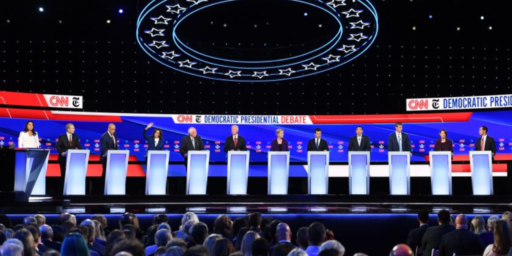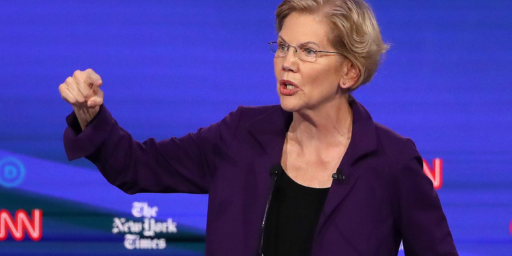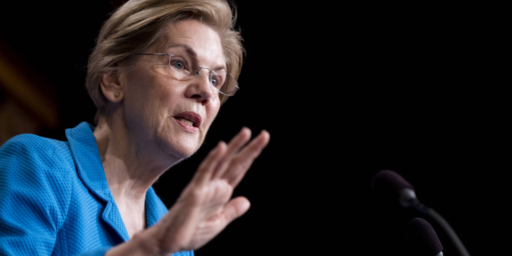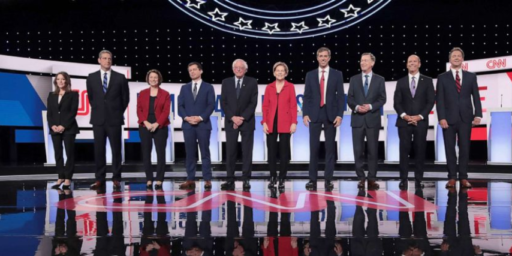Early 2024 Polling
Election year is upon us, but the polling is still a bit fuzzy.

So, USAT has the latest polling panic (for those who fear a Trump re-election, anyway) headline: A fraying coalition: Black, Hispanic, young voters abandon Biden as election year begins.
In a new USA TODAY/Suffolk University Poll, Biden’s failure to consolidate support in key parts of the coalition that elected him in 2020 has left him narrowly trailing Trump, the likely Republican nominee, 39%-37%; 17% support an unnamed third-party candidate.
Emphasis mine.
Look, I understand what the pollster is doing here and agree that having 17% pick a mystery candidate indicates some level of discontent with the known candidates. But the thing is, there is always some level of discontent with the known candidates, especially this far out. And the magical appeal, as has often been noted here at OTB, of the “unnamed” candidate is often beyond the ability of many to resist.
Now, it is also true that actual third-party candidates poll relatively well at the moment.
When seven candidates are specified by name, Trump’s lead inches up to 3 percentage points, 37%-34%, with independent Robert F. Kennedy Jr. at the top of the third-party candidates at 10%.
But, of course, when you give respondents a list, that will lead a significant number of them to choose one of the additional options in a way that does not replicate actual voting. Moreover, I guarantee that RFK, Jr. gets a name recognition boost (not to mention that no third-party candidate is going to win 10% of the vote come November).
Now, yes were I a Biden strategist, I would not be happy with those numbers and I would especially be concerned by the following:
Biden now claims the support of just 63% of Black voters, a precipitous decline from the 87% he carried in 2020, according to the Roper Center. He trails among Hispanic voters by 5 percentage points, 39%-34%; in 2020 he had swamped Trump among that demographic group 2 to 1, 65%-32%.
And among voters under 35, a generation largely at odds with the GOP on issues such as abortion access and climate change, Trump now leads 37%-33%. Younger voters overwhelmingly backed Biden in 2020.
Still, the question is: will those voters go to Trump, a third-party candidate, or will they stay home?
The reality is that it is early in the process (as hard as that is to believe for that kind of people who might read this site). Many voters will not engage in this process until the summer, if not later. And apart from some major event occurring (health for both candidates, an unforeseen scandal for Biden, or certain legal outcomes for Trump), I think we are going to see the question boil down to whether Trump can muster support in key swing states to win the Electoral College. The bottom line remains: we are divided and polarized into partisan camps. On the national level, the Democratic camp is slightly larger but the geographic distribution of voters combined with the exigencies of the Electoral College could allow Trump to ride around popular vote inversion into the White House.
My anticipation, going into this election year, is that young voters and Black voters, who may currently be wondering about third parties or just staying home, will realize, in the main, that their choices really are Biden or Trump, and that they will choose Biden, even with reservations about his age or about the economy.
For some level of comparison, I dug up the following polls from January of 2020 (but a few weeks later in both cases). It is hard to fully compare since in January 2020 the head-to-head for November was not as clear as it appears to be now. Note that in 2020 Biden went on the win 51.31% to 46.86% (with 1.79% going to “others”).
For further context, Trump won 46.2% of the popular vote in 2016 (to HRC’s 48.2%). Recognizing the distorting effects of the Electoral College, it is still worth pondering if Trump’s overall ceiling isn’t somewhere around 46ish percent.
From IBD:
In head-to-head general election polling, each of the top five Democratic candidates — with the exception of Elizabeth Warren — held slight edges over President Trump. But their leads were well within the margin of error.
Joe Biden (48%-46%) and Michael Bloomberg (47%-45%), both led President Trump by 2 points, while Bernie Sanders (48%-47%) and Pete Buttigieg (47%-46%) led by one. Trump edged Warren (47%-46%).
In potential head-to-head matchups for the November election, all top candidates are well within the margin of error, President Trump trails Sanders 51% to 49%, is tied with Warren and Biden at 50% each and leads Buttigieg at 51% to 49%.






I’m checking my tea leaves…nope, tea’s way too weak. As noted above, most people aren’t paying attention until summer vacation is over. However, pundits gotta pundit, and the sky is always falling, little chicken.
My poll of one voter. Me. I’ll be 76 in two days and remain a white male. I’ll vote for President Biden in the Illinois Democratic Primary on March 19 and again in the general election in November.
Pollsters are free to use this data as they see fit.
Panic is preferable to 2016-style complacency. Trumpism is a dangerous threat. Be afraid, be very afraid.
Trump won 46% of the popular vote before it was confirmed on national TV that he’s a rapist, that he held Ukraine’s military aid hostage to get fake dirt on the Bidens, that he incited an insurrection to overturn his electoral loss, that he would (if elected) use the federal government to exact petty revenge on his personal enemies and political foes…
That his popularity doesn’t seem to have been affected by any of this is the saddest fact in America at the moment.
According to an article I read a while ago in WaPo, Spanish speaking media has tilted right over the past few years, particularly Univision.
https://www.washingtonpost.com/politics/2023/11/14/trump-univision-biden-election/
I don’t think the poll numbers are just people flirting with RFKJr before realizing that he is insane or whatever and then going back to Democrats as a less-worse default, I think there’s a much steeper road to getting those voters back in the coalition.
I wouldn’t be surprised if there were similar things going on with largely Black media (I would know nothing about Spanish-speaking media if WaPo didn’t write about it… Black media is also invisible to me)
Have Millennials started buying houses? I thought the plan was to saddle them with crushing debt so they couldn’t and will always blame the man (typically the man is Republican).
Anyway, I’m going to go back to complacency. I live in Seattle, so not a swing state or even a swing district and my vote doesn’t matter.
I’ve noticed that there is a basic difference between how I (and people like me, poor things) see politics, and how most people do. Most people are trying to be virtuous, and be seen as such. Not a discreditable desire, on the contrary democracy doesn’t really work in the absence of virtue.
I also want to be virtuous, but virtue takes second place to winning the game, because virtue is impotent absent power. God knows I love being right and I (ahem) successfully avoid undue modesty when I am right. But I’ll take a compromised win over a principled failure every day of the week. I’d rather have 60% of the cake than wave goodbye to 100% of the cake because I won’t make a deal.
My wife and I have a running disagreement. She’ll say, look how far you’ve gotten in dealing with Hollywood. You have an agent at one of the big three, your work has wormed its way into Hollywood executive suites, blah blah blah. My response is that none of that matters in the least if, in the end, I don’t have what I set out to get. But if I get most of what I want, say a movie rather than a TV series, that’s cool. If I get neither, well, then I’ve failed, full stop. The journey is not the thing, victory is.
I admire the virtuous, but I have little patience for their putting their own emotional needs ahead of what I see as the true goal: winning, so that we can do the things we want to do. Our very democracy, our liberty, is on the line. We may lose our country. Things are different, the stakes are much higher, so this is not the time for petulance or whining about, ‘what did I get, huh? What about meeee?’ IMHO patriotism, love of country, and hope for the future, requires that we keep, ‘eyes on the prize,’ not eyes on my social media likes’ or reputation or self-image. Less ‘be’ and more ‘do.’
If Black voters, or Hispanic voters, or young voters fail, they will reap what they have sown. They can feel fully virtuous about their principled vote for Stein or Kennedy as they send their kids to schools that teach the joys of slavery, or how immigrants are poisoning our blood, or how women should really just stay home and have babies.
@DK:
I sort of agree, with caveats.
First of all, as I’ve said there isn’t the remotest chance there will be a return to 2016-level complacency, when a large chunk of the public convinced itself a Trump victory was a literal impossibility. One can make a legitimate argument that some Dems are overconfident right now, and overconfidence isn’t good. But even that isn’t anywhere in the universe of what people were thinking in 2016 about Hillary’s inevitable triumph over the orange reality star.
Second, while 2016 definitely showed the destructive effects of complacency, 2022 showed how a pessimistic narrative can also be damaging. If Dems could use a time machine to get a do-over of that cycle, you really think they’d end up losing the House? The narrative that the House was gone worked like a self-fulfilling prophecy, leading Dems to think it wasn’t even worth bothering. Similarly, the narrative that Biden is in trouble could have a destructive impact on Democratic morale, both at the campaign level and in terms of individual voters. We need to watch out for that.
@Kylopod: Democrats need to use their recent voting history to come to the realization that they need to show up. Every. Body. Every. Time.
ETA: Whether panic is the way to get there is someone else’s call to make. But Democrats need to understand that “not even worth bothering to vote” is the way to permanent minority party government.
The pandemic made 2020 unique politically, so from February onwards this year, the events of four years ago are not going to help understand what’s happening in 2024. If we get our noses out of polls and focus groups and look at circumstances objectively, Biden is in good shape to be re-elected. The more important question is: re-elected to do what? Preside over another four years of government dysfunction and social fragmentation?
The most concerning point Steven makes is this: “The bottom line remains: we are divided and polarized into partisan camps.” This seems to me to be the slow-motion crisis confronting America’s constitutional democracy. Almost half the country supports for the presidency a man profoundly ignorant, unbelievably immature, comically self-centred and utterly unfit for public office. Why? I’ve read lots of attempts to explain it. The only persuasive one is that almost 50% of Americans loathe an imagined “shadow government” so passionately that they will follow a leader who is obsessed with wiping “the vermin” out.
It’s a frankly terrifying idea; one that upends all the conventional notions of “shared basic values” and commitment to democratic constitutional norms. It’s 320 million people living in a forced marriage with one partner finally screaming “I WANT A DIVORCE!” and resorting to increasingly irrational, violent language any time the other one tries to engage in a constructive conversation.
I’ve no idea why it’s happened or what can be done to change America’s trajectory, but it’s looking more and more inevitable that bad times lie ahead.
I see this sentiment (“it’s still early”) invoked a lot. I hear myself invoke it too.
I wonder, though, what is “early” and how did we come to define it? Is there a (semi)-solid historical basis?
And, if so, does that still hold today when common wisdom seems to be that “things are different now”?
I also wonder what “engage” means here. Time spent pondering electoral politics? Candidate policy?
Common wisdom seems to be that the median voter is “low information” — I believe someone around here refers to them as having the intellect of aggregated minerals.
So even if “it’s still early” in the process, I question whether time will appreciably change voter wisdom.
@Mimai: It is empirically early. Voters will not focus, en mass, until we are far closer to actual votes being cast.
The candidates are not even official yet, and won’t be until late summer.
@Mimai: Just look at the numbers, 17% for an unknown third part candidate, 10% for RFK, Jr., upper 30s for Trump and Biden, etc.
I think the conventional thinking for “it’s early in the process” is because in most traditional election campaign seasons, it’s been unreasonable to predict how things are going to shake out before any primary elections or caucuses have happened. This is an unusual year, and we can say with fair confidence that, barring car/pedestrian or window frame failure accidents, we DO know who is going to be running in each party.
I think that Gustopher’s comment about the level at which who will win in Washington state is the kind of issue where “voter engagement” comes into play. Our individual votes (or lack thereof for ~30% (?) of eligible voters nationwide) play a miniscule outcome in the election where the Electoral College results weigh as much by geography as by ballots cast and the outcome in as many as 45 out of 50 individual states is a foregone conclusion–even without knowing who will run.
@Steven L. Taylor:
Sorry if this comes across as tedious, but “empirically early” compared to what? I’m trying to operationalize “early” vs. “timely”.
And at the risk of being even more tedious, it’s not clear to me what “focus” means here or how it matters. Unless you mean actually pulling the lever, mailing the ballot, etc.
“Just look at the numbers” isn’t very helpful. Indeed, it seems rather circular to me.
(feel free to ignore me… I wish I had that option)
@Mimai: Historically, third party candidates get about 2% of the vote. Right now, third party and other is 30%.
Until that number starts starts moving down, I think we are in “too early.”
That said, when that number starts moving down, I hope Democrats are out and about, spreading a message of what a vote for Democrats is a vote for.
I wonder if there is a regular date when that number starts moving, or whether it is different every year. Either way, we aren’t there yet.
@Just nutha ignint cracker: The thing is, hard as I find it to understand this, that 2024 will be Trump v. Biden hasn’t sunk in for most voters. So it’s early.
@Gustopher:
It’s incorrect to suggest there’s a historical norm. Some elections, “others” have been less than 1%. But Anderson got 6.6% in 1980, while Perot got 18.9% in 1992 and almost half as much (8.4%) four years later.
@Ken_L: I think the only consistent historical pattern with third-party candidates is that they always do significantly worse than their polling.
In 2016, Gary Johnson sometimes polled as high as 9%. He ended up winning 3.3%.
In 2000, Nader sometimes polled as high as 6%. He ended up winning 2.74%.
In 1992, Perot sometimes polled as high as 39%. He ended up winning 18.91%
In 1980, Anderson sometimes polled as high as 24%. He ended up winning 6.61%
In 1968, Wallace sometimes polled as high as 21%. He ended up winning 13.53%.
You get the idea. When it comes to RFK, I think the only thing we can say with any fair amount of confidence is that he won’t get anything close to 22% on Election Day.
@Kylopod: Nevertheless it’s not a comforting thought that if Kennedy does as well as those you mention, he could get anywhere from 6 to 10% of the vote, which would have unpredictable consequences. Add in a possible No Labels candidate and Brother West, and America might be in uncharted waters.
@DK: Well, not panic, but a good and proper bit of fear quite well advised. Notably some good and 0proper fear and mongering of said fear as to the downside of a Trump II with the risk of more organised assault on all perceived enemies.
Focus such fear on the specific electoral demographics of the swing states, rather than the error of national analysis…@Just nutha ignint cracker: equally that your choice is not the ideal you want to achieve but really a finding enough votes to block someone who this time risks not merely being a cringe worthy clown, but someone who cause real regressions, not just lost potential. Défense.
@Ken_L: excessive oh woeism. Partially you have collectively become a Uni dorm lot of talk only to the properly pure, campus activists rather than trade union organisers. That is losing potential backstopping blue collar votes, even smongst the ethnic minorities.
@Mimai:
Compared to every election cycle ever for which such polling exists. It is factually true to say that it is too early in this process to take any specific numbers seriously, especially the ones I quoted above.
If a baseball team starts the regular 162 on a hot streak, it may be indicative of how they will finish, but it would be too early to state that they would win their division (even if they won it last year). Maybe they will. Maybe they should be favored due to other factors, but anyone who knows anything about baseball knows it is too early to declare with certitude that what is happening at the start of the season will be true at the end. This is especially true if the team doing well is one unlikely to be able to sustain its winning streak (i.e., an RFK Jr team that is out-performing for a hot minute).
The analogy is imperfect, but I think the basic notion hopefully illustrates the point.
I agree that the analogy is imperfect. Very. 😉
I’m not arguing that the numbers for unnamed candidate or RFK are rock solid. Or to be more precise, that they will closely align with actual voting behaviors come November.
I just don’t find the reasoning all that compelling: It’s too early because of the whacky numbers. The numbers are whacky because it’s too early.
I suppose my question* is: What is the (empirically derived) threshold differentiating “too early” and “timely”?
*I don’t expect you to answer my question(s) — not because you can’t, but more because you likely have better things to do than entertain my ignorance.
@Kylopod:
Yes, but even in well-informed commentariat here, there are those unable to resist the Twitter gliterrati’s suspect narratives.
In 2022, some of us said there was no way Herschel Walker would ever be a senator from Georgia, that special election results were showing Democrats outperforming expectations, that a lot of the polls showing the Big Red Mirage were bunk, that quality polls indicating otherwise were being ignored, that Biden was right to highlight MAGA extremism and Trumpist threat to democracy.
For this Biden was told he was out-of-touch and making an error, while the rest of us were derided as wishcasting pollyannas and told we were ignoring the potent power of anti-wokeism and “LatinX” and Republicans’ emerging working class, multicultural coalition.
You’re right: Democrats could have performed better in 2022 had they not suppressed their own turnout by falling for this nonsense. I see no evidence we’ve learned from this.
When I said here that actually, yes, working class people do what tyranny means and yes, Democrats should center the fight against Trump’s tyranny — some insisted I was wrong (I’m not, just like Biden wasn’t in 2022).
I could also say that in 2024 Democrats will win around same share of black and Latino voters as they have recently, defying the the hype about Republicans inroads just as in 2022. Further, any poll showing Trump winning youth voters over Biden is a garbage poll not worth publication. And that the many polls showing Biden ahead of Trump with likely voters are being deliberately ignored by the legacy media, as is the fact that Democrats just keep winning elections.
We know the response: doom, gloom, and no, you blind pollyanna, Democrats are actually losing everything, everywhere, all at once.
If the smart folks here are too timid to reject phony push polling and lazy narratives, that does not bode well for the general public.
@DK: In any election cycle, no matter what the media consensus is, there are always going to be partisan echo chambers projecting optimism on their side. I remember perusing forums in 2010 and 2014 and getting told not to believe the hype, that the Dems would do a lot better than people were saying.
Even in 2022 the red-wave narrative was not universal or consistent in the media. There were many pieces arguing that current polarization would limit Republican gains, that Dobbs threw a monkey-wrench into the usual midterm patterns, that Trump would hurt the GOP’s chances by firing up Dems in ways that defied their traditional habit of staying home, that the special elections and even the polling didn’t support the narrative that Dems were going to get annihilated. As the midterm grew nearer, though, these doubts just got sort of drowned out.